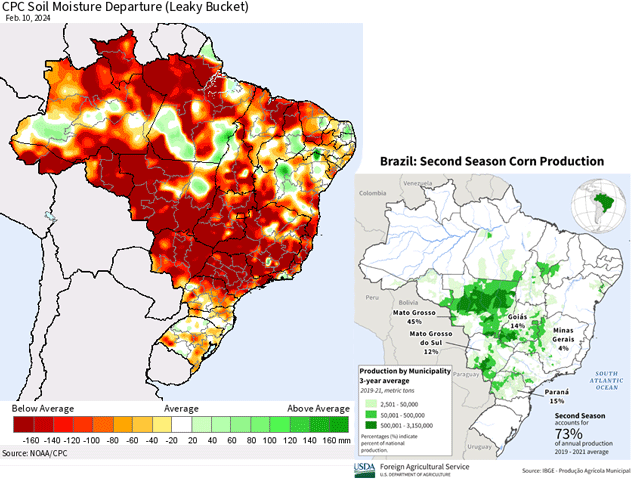South America Calling
Rain Not Enough for Brazil's Safrinha Corn Crop Yet
Rainfall in Brazil has shown a pretty good El Nino pattern so far this growing season. The above-normal temperatures in the central Pacific Ocean have caused lower coverage and amounts of precipitation across most of Brazil, especially central Brazil during the last several months. Rains have still fallen, and put some potential out there for some decent production of the first-crop soybeans. But the rains have not been filling soils with their usual supply of subsoil moisture for the safrinha (second-season) corn crop.
Producers in Brazil are usually blessed with good enough weather to double-crop soybeans with corn. The typical process involves planting a short-season soybean in September and October, harvesting in January and February, and immediately planting corn. While wet season rains fall, they build soil moisture in the subsoil levels that can sustain the corn crop after the wet season rains end in early May, just past the pollination period for the corn. The crop then uses the subsoil moisture to fill out the grain and produce a decent yield.
However, weather challenges can significantly throw off the ability to produce good yields in the country. Hot and dry stretches in October and November significantly delayed soybean plantings, damaged the crop, and caused widespread replanting. When the rain turned on in December and the period since, they have largely fallen at around half of the normal coverage and amounts. The result has been a "good-enough" rain for the damaged soybean crop, but not enough to truly build in the soil moisture they need for their safrinha corn crop. At least not yet.
P[L1] D[0x0] M[300x250] OOP[F] ADUNIT[] T[]
The area from northern Parana up to Mato Grosso, and east to Minas Gerais, accounts for roughly 90% of the safrinha corn production in Brazil. Subsoil moisture is estimated by the Climate Prediction Center (a division of NOAA) to be more than 100 millimeters (about 4 inches) short on the soil moisture currently. That puts most of this production area in the top 5 percentile for driest soil moisture reserves at this time of year. This level of dryness is not enough to sustain the safrinha corn crop. But the country is still in the heart of the wet season and has another two months or so before those rains start to really thin out.
However, the DTN forecast is not optimistic about rainfall in Brazil. While DTN and model forecasts continue to produce showers through the end of March, they do so at a reduced pace compared to normal. Drier-than-normal rainfall is not what the safrinha crop is looking for it relies so heavily on the built-up soil moisture.
Another issue to factor in would be the planting of the safrinha corn. It is currently on a good pace, but the amount of soybeans that were planted late or replanted should put a good portion of the corn crop outside of the favorable weather window and be more susceptible to the dry season.
If the rain that comes during the next six-to-eight weeks is not heavy enough to add to the soil moisture, the corn crop could look good at the end of March, but poor by the start of May. There should be major concerns for the safrinha corn crop going forward, even though conditions are currently pretty good.
To find more international weather conditions and your local forecast from DTN, visit https://www.dtnpf.com/….
John Baranick can be reached at john.baranick@dtn.com
(c) Copyright 2024 DTN, LLC. All rights reserved.






Comments
To comment, please Log In or Join our Community .